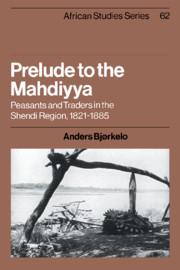Book contents
- Frontmatter
- Contents
- Figures
- List of maps
- List of tables
- Preface
- Acknowledgements
- Abbreviations
- Weights and measures
- The Sudan in the nineteenth century
- Introduction
- 1 The Ja'alī Kingdom of Shendi and its destruction
- 2 Shendi's economy on the eve of the Turkiyya
- 3 The Ja'aliyyīn under Turkish administration
- 4 The transformation of agriculture
- 5 Taxation
- 6 The transformation of commerce
- 7 Conclusion: dispersion and return
- Appendix: Three contracts from the archive of 'Abd Allāh Bey Ḥamza
- Notes
- Sources and bibliography
- Index
- OTHER BOOKS IN THE SERIES
6 - The transformation of commerce
Published online by Cambridge University Press: 31 October 2009
- Frontmatter
- Contents
- Figures
- List of maps
- List of tables
- Preface
- Acknowledgements
- Abbreviations
- Weights and measures
- The Sudan in the nineteenth century
- Introduction
- 1 The Ja'alī Kingdom of Shendi and its destruction
- 2 Shendi's economy on the eve of the Turkiyya
- 3 The Ja'aliyyīn under Turkish administration
- 4 The transformation of agriculture
- 5 Taxation
- 6 The transformation of commerce
- 7 Conclusion: dispersion and return
- Appendix: Three contracts from the archive of 'Abd Allāh Bey Ḥamza
- Notes
- Sources and bibliography
- Index
- OTHER BOOKS IN THE SERIES
Summary
THE TURKIYYA FRAMEWORK
As Lejean wrote in a report in 1862, the imposition of the Turkish colonial regime radically disrupted and changed traditional commerce. It was widely held, not only in the Ottoman Empire, that trade was vital to economic development and prosperity, but the fact that commerce between unequal partners has a tendency to turn into exploitation was given less consideration. The Sudanese traders, confronted with the new situation, sought to reformulate their strategies in order to cope with the new restrictions as well as to take advantage of the new opportunities.
With so much emphasis on commercial exploitation it was only natural that merchants of all categories, both local and foreign, came to play a significant, if not always heroic role in the spread of the colonial economy. However, in areas where huge profits were expected, the government tried as long as they could to keep the independent traders out, and for this and several other reasons, the relationship between the Turks and the traders fluctuated. The Turkish Sudan attracted foreign traders and speculators of every type, some of whom made fortunes. Among the Sudanese traders, Ja'aliyyin and others, some learned the new rules of the game quickly and became successful, particularly in the diaspora, whereas the majority remained or became petty traders.
An economic system may be defined substantively as the production, circulation and consumption of commodities. The bulk of the commodities in circulation were foodstuffs, natural products and manufactured commodities of local, regional and foreign origin.
- Type
- Chapter
- Information
- Prelude to the MahdiyyaPeasants and Traders in the Shendi Region, 1821–1885, pp. 104 - 136Publisher: Cambridge University PressPrint publication year: 1989



